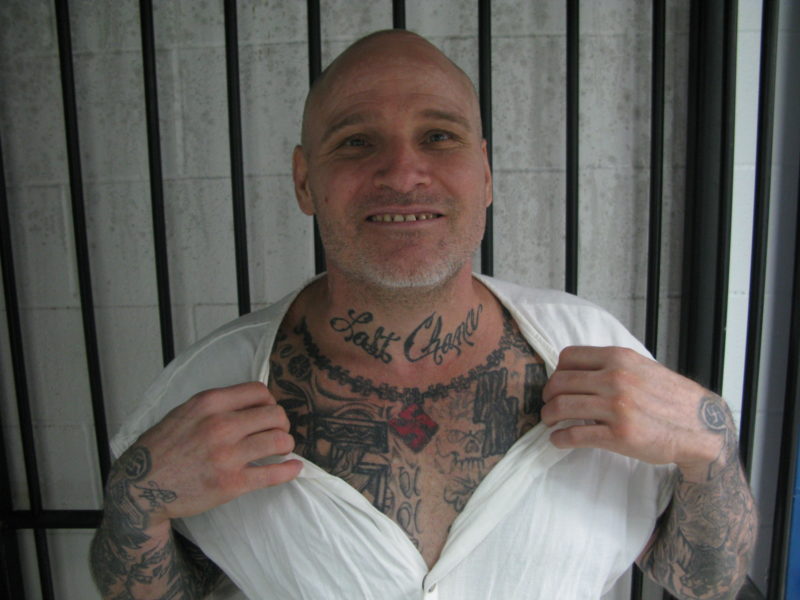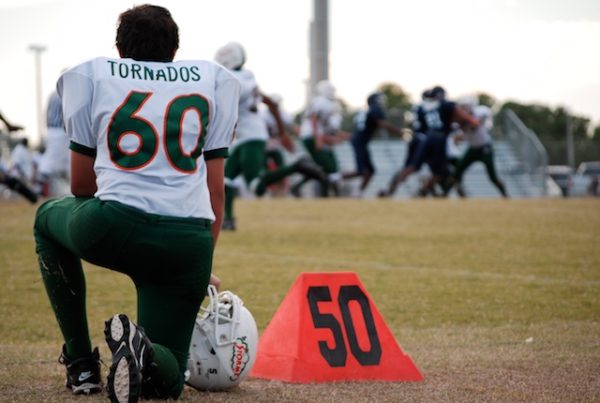Editor’s note: This story contains graphic depictions of a crime.
The federal government is trying to disrupt the Texas operations of the Aryan Brotherhood, a white supremacist prison gang. It began in California in the 1960s and spread to Texas in the 1980s. Chapters formed across the country, but the federal government decided that those in Texas were among the most brutal and violent. In 2008, the federal government launched an aggressive six-year operation that landed 75 members of the Aryan Brotherhood in prison.
This highly exclusive, all-white criminal organization rarely talks to outsiders, least of to all members of the press. But NPR’s John Burnett spoke with James “Chance” Jones, a senior major in the Aryan Brotherhood of Texas (ABT).
Jones’ job was to decide what disciplinary actions should be taken against gang members that were suspected of crimes against the organization: snitching to the cops, forgetting the group’s creed, or ripping off another member.
Burnett says Burns had been sitting in administrative segregation, on lockdown for 23 hours a day, for the past two years.
“I suspect [he] was really bored and wanted to talk about the family that he’s been a member of for many many years,” Burnett says.
The organization calls itself a “family” and a “brotherhood.” Burns’ nickname is “Chance,” for the “Last Chance” tattoo he wears on his neck, right below his chin. Burns explained it to Burnett: “By the time they send me to see you, it’s your last chance.”
“Here we are in this high-security prison in south Texas, they bring him in handcuffed – he’s just all buffed up because all he does is do push-ups all day in his cell,” Burnett says. “He’s got swastika tattoos from his neck down. They put him in this kind of 19th-century cage with big black bars and he’s got this grin with this meth-mouth.”
Burnett and Burns spoke about one of the gang member’s most notorious crimes – he burned a symbolic tattoo off of the skin of one of the members of his gang with a blowtorch.
Burns: That patch on his side, I burned it off.
Burnett: With a blowtorch?
Burns: Right.
Burnett: What was that like?
Burns: It stinks.
Burnett: What stinks?
Burns: Just your skin. It catches on fire – your grease in your body. And on the side there’s a lot of fat there. So I burned it off his arm and on his back.
Burnett says the tattoo is a revered symbol of membership within the group.
“It’s blood in and blood out,” he says. “You have to commit a murder or a violent assault to get in the gang, and once you get that patch you have to really commit quite an offense to get it burned off in such a brutal way.”
Burnett also wanted to know whether what he’d heard was true – that the federal government had indeed decapitated the ABT in the state.
The Racketeer Influenced and Corrupt Organizations Act (the RICO Act) helped the federal government charge and arrest members of the white supremacist group. The wrap-around law allows the government to take down all parties involved in criminal organizations, not just the individual players who may have directly committed a crime.
After prosecution, members of organized crimes were dispersed all over the country, to prohibit them from further contact with their group members.
“If you’re sitting in a federal prison in New York state,” Burnett says, “you may not meet another ABT member. Your girlfriend is not going to be close enough to come visit you and then you can give her messages to give to the gang back home. So you really do weaken them when you move them all over the country.”
Burns told Burnett that the government helped the organization “trim our bad wood” – they didn’t want those guys in their group anyway if they were going to snitch on the family.
“Regardless what James Burns tells us, we know the gang has taken a big hit,” Burnett says. “But of course, Burns also wanted to put a good face on a bad situation. … To a certain extent he was doing some public relations. I think he wanted to kind of tell the world the gang was down, but not out.”
More than half of the convicted Aryan Brotherhood members talked to authorities – a cardinal sin within the organization. So what did Burns have to say about their betrayal?
Burns: I love them dudes. I still do.
Burnett: But?
Burns: Ain’t no buts to it. I still love ‘em. I mean they’re real genuine guys and it took a big man to get in front of the Aryan Brotherhood and say that they did something, wouldn’t you think?
Burnett: So what happens to them now? So they have a death sentence against them?
Burns: I don’t know.
Burnett: I mean, isn’t that what happens to a snitch in the Aryan Brotherhood?
Burns: I don’t know.
“While he was saying ‘I don’t know,’ he was nodding his head ‘Yes,’” Burnett says. “Every one one of those guys has a death sentence against them. In fact, one of the generals that testified for the government – named Terry ‘Lil Wood’ Sillers – Burns has a tattoo of him on his neck with ‘Lil Wood’ hanging from a gallows.”
Post by Beth Cortez-Neavel.
















